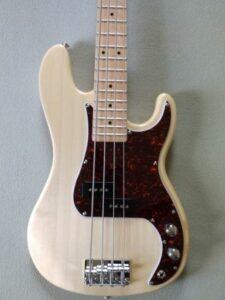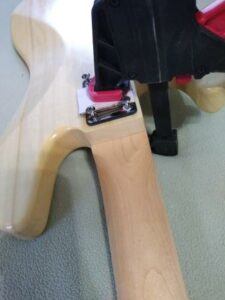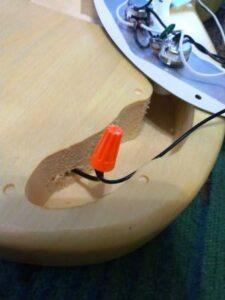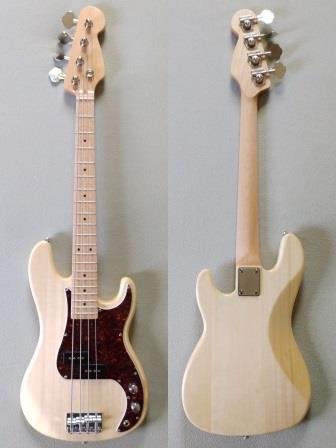
If you are a beginner, a DIY electric bass kit is one of the best places to start. Even if you are a seasoned builder, a bass is still one of the most fun and rewarding kits. But then, I am primarily a bass player so I may be a little biased. This short scale Solo Mini P-Bass is a low cost (about $150) and easy build. It is also comfortable to hold and play.
The mini P-bass is about the same size as a Strat-style 6-string electric, measuring 40-inches overall and having a 28.6-inch scale. If that number seems a little strange, there is a reason why it is used. This bass is very similar to a Squier Mini-Precision bass, and the scale length is based on mass production tooling. It is exactly the same as a 25.5-inch scale Strat, with two additional frets added at the headstock (and, of course, a couple of frets removed at the other end). Frets 3 and forward are spaced exactly as the first fret and forward on a Strat. And, if you want to check it out, a 30-inch short scale bass (actually 30.3-inches) is the same spacing with three additional frets, while a 34-inch scale is the same spacing with five additional frets. Cheers to mass production tooling!
The Solo Mini P-bass has the standard single P-type two-piece pickup with a volume and tone control circuit. As with all kits, it came with a set of strings. I actually ended up using the kit strings, for reasons detailed below. Even so, this bass sounds better than expected. Perhaps with a change of strings it could be even better.
Unpacking the Kit
Being a bass kit, the Solo Mini P-bass has minimal parts. The box was was the standard 3-compartment package, with the pre-wired pickguard and a bag of hardware at one end. The other two compartments contained the body and the neck. Everything was packaged securely and arrived with no damage by the shipper.
There were no significant dings on the body in the kit I received, though some reviews on the Solo website indicate dings on the body. The neck and fretboard were near perfect, straight and with no sharp fret ends at all. Again, some of the other reviewers indicated that they had to do a lot of work on the frets, but mine were good right out of the box.

This kit uses full-sized Fender style open gear tuners, and the headstock is pre-drilled. The neck fit snugly in the body, and I did a test fit using kite string to check alignment. It was spot on. Clearly I had received a quality kit, a welcome change from some of the previous kits (Pango) that I struggled with.
Finishing the Body
I find basswood to be difficult to finish, and I have only been successful with painting – which I do not like to do. Being somewhat of a perfectionist and not having a good paint booth, I always found flaws in the results of my efforts with spray cans. I really hoped I could do a natural finish on this bass, and I was not dissapointed.
The basswood body of this Solo Mini P-bass has a beautiful straight grain. Even though it is in three pieces, the sections are very well matched and, just looking at the front or back, you would never know it wasn’t one piece. After sanding off the factory-applied sealer (I wish they didn’t do that), this wood took the Tru-Oil Gun Stock Finish very well. I was pleasantly surprised.

With it having a maple neck and fingerboard, I chose to use the Tru-Oil finish on everything. I used 0000 steel wool in between coats, and then let it all just set for a week before proceeding with the assembly.
Assembling the Solo Mini P-Bass
It’s a bolt-on neck, and I always use a clamp to hold the neck heel in place against the body cavity so there are no gaps before driving in the wood screws into the pre-drilled neck. That is always by hand, never with a power driver, and I drag the screws across a bar of soap first. I make it a habit to check alignment at multiple times during assembly.

There were no pickup springs in my kit, which is something mentioned frequently in other reviews. It did come with dense foam pads, adhesive on one side, which I assume was to be used behind the pickup. This is the way Fender used to do all of their P-bass pickups. However, the description on the kit said the kit includes “Mounting Springs for pickup height adjustment.” I asked Solo customer service for these springs, and they sent them to me without hesitation. Kudos to Solo customer service – much better than I have experience with other companies (in particular, Pango). I also noticed that Solo’s kit description no longer list these springs. Again, this shows the responsiveness of Solo in making corrections and keeping things up-to-date.

Assembly didn’t require soldering as the pickguard was “loaded” and pre-wired. I chose to add my own ground wire to the bridge and use a solderless wire nut to connect it to the provided ground on the assembled pickguard. This is just so that I can more easily remove the loaded pickguard without having to unsolder the ground.
Some Things To Consider
The strings that come with the kit are really pretty good, and as stated above I ended up using them. That is rare for me, as I always have D’Addario EXL bass strings on hand and prefer to use them over the unknown kit strings. However, this Solo Mini P-bass presented an out-of-the-ordinary situation for me. Although I have D’Addario EXL-170S strings in my arsenal, they don’t really fit on this kit – specifically, the E-string. The EXL-170S strings are designed for a 30-inch short scale bass, and the distance from the ball end of the E-string to the point where the it tapers down for the tuning machine is about 32.25-inches. But on this 28.6-inch scale bass, the distance from the back of the bridge to the tuning machine is 31.5-inches, which would leave the thickest part of the string wrapping around the tuner peg.
I do think the strings made for the Ibanez Gio Mikro bass would fit. The Mikro is also a 28.6-inch scale. If I decide to change the strings, I will probably go with those Ibanez IEBS 4 Coated Nickel Wound Mikro Bass Guitar Strings. But really, the strings that came with it sound and feel good.
Solo rates the Mini P-Bass as a beginner kit, using their graphic to indicate a build challenge level 1 out of 5, with 5 being the most difficult. For comparison, they rate the full-sized PMBK-05 bass with both a P-style and MM-style pickup (which I have previously built) as a level 2, their flamed-maple Les Paul 6-string with a set neck as a level 3, and their ES-335 style kit as a level 5.
Solo customers rate this kit about 4.5 out of 5 stars on the Solo website, Amazon customers give it 4.4 out of 5 stars. It is worthwhile to read the reviews on both sites.
Solo says it is 40-inches in overall length. Mine measures exactly 40-inches from the top of the headstock to the bottom of the body. But there is an additional 3/8-inch for the strap button on the bottom. My Solo Mini P-bass will just barely go in my generic electric guitar gig bag, and the zipper is very tight. Not only is it almost too long, these giant (actually standard sized) bass tuners make the finished headstock considerably wider than most electric guitars. The body is smaller, the neck is shorter, but the headstock is the same size as my full-size Precision Bass. However, this bass fits very nicely in my TKL Deluxe Profile Electric Guitar bag. I’m sure there are other higher end bags that will work as well, but the inexpensive generic bag isn’t going to cut it.

Recommendation
So hey, if you are looking for a fun little bass guitar to build and want one you will also enjoy playing, consider this Solo Mini P-Bass. You can do some upgrades on it now or later, or just leave it as-is. You won’t be disappointed.
Have you built this Solo Mini P-Bass, or maybe another short-scale bass? Please leave a comment for us.